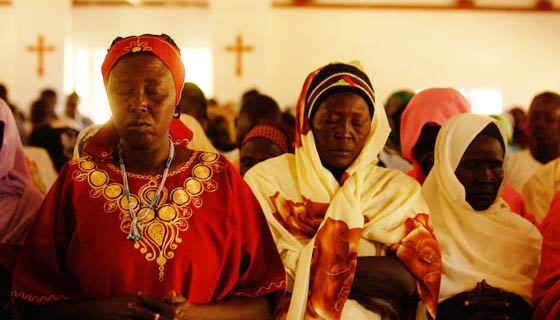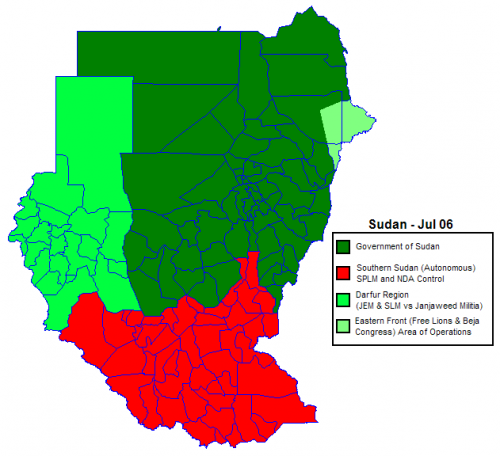Struggling to 'get' religion in South Sudan
 Obviously, oil and, thus, big oil money plays a major role in the tensions between Sudan and South Sudan. Most of the current nation of Sudan's oil reserves are in the South. Obviously, there are racial issues, with the north being dominated by light-skinned Arabs, while the vast majority of the population of the South Sudan consists of dark-skinned Africans from various tribes.
Obviously, oil and, thus, big oil money plays a major role in the tensions between Sudan and South Sudan. Most of the current nation of Sudan's oil reserves are in the South. Obviously, there are racial issues, with the north being dominated by light-skinned Arabs, while the vast majority of the population of the South Sudan consists of dark-skinned Africans from various tribes.
At the same time, it is obvious that religion is an important part of the decades of bloodshed and slavery -- most of it ignored by Western media -- that has now led produced a dramatic week-long referendum that could produce an independent nation in South Sudan.
It's obvious, but that doesn't mean that many mainstream journalists are totally comfortable with that reality, with some journalists insisting -- literally -- that the decades of slaughter in the region wasn't that big a deal, but merely a "pet cause" of the dreaded religious right. Some journalists just don't get Sudan.
It's easy to sense some of that discomfort with the religious element of the civil war while reading the following A1 Washington Post news feature about the drama at the polls -- which began this weekend. Most journalists prefer to talk about ethnic and sectarian strife and leave it at that.
Here are some telling images from early in the report:
Before dawn, large crowds stood in long snaking lines outside polling stations. Amid heavy security, they sang and danced, chanting such lyrics as, "We are here to thank god today."
"We have been waiting for this day all our lives," said Suzy John, 28, a businesswoman who was waiting in line at the mausoleum of John Garang, the south Sudan rebel leader who died several years ago in a helicopter crash. "It means self determination, freedom, hope for the future and hope for the future of our children."
That's an interesting chant. The people of South Sudan are largely Christian or are part of various animist, tribal religions. With that lower-case "g" -- I guess readers are supposed to assume that these are animists? Could the reporter hear a difference between "g" and "G" while covering this scene? Just asking.
The story does make it clear that concerns about Sudan have become bipartisan, with the second Bush White House pushing for the peace treaty that led to this week's voting. Now, the Obama White House is highly involved in making sure that the vote actually takes place.
In this passage, the Post does give the reader a short, but accurate, look at what is happening.
More than 2 million people died in the 22-year-long civil war, which pitted Arab Islamic rulers in the north against the south's animist and Christian rebels. Since 2005, when a peace treaty was signed, the south has been semiautonomous, ruled by the former rebels of the Sudan People's Liberation Movement. As a condition of the peace deal, brokered by the George W. Bush administration, the south was guaranteed a vote on independence.
Nearly 3.9 million people have registered to vote, and a turnout of 60 percent is needed for the results to be valid. Tens of thousands of southerners have arrived here from northern Sudan and from around the world to participate, some carrying all their possessions and hoping to resettle in the south.
The killing in southern Sudan, though, hasn't stopped. Last year, at least 900 people died in tribal fighting and 215,000 were displaced, aid groups say. Weapons are widely available, and militias are abundant. Clan rivalries and corruption are rife. And the gulf between light-complexioned Arabs and darker-skinned Africans remains wide.
 While the story includes some hints of the role faith has played in the history of this civil war, it is often hard to know who is who.
While the story includes some hints of the role faith has played in the history of this civil war, it is often hard to know who is who.
For example, in addition to the Post's earlier "god" reference, God with a large "G" appears near the end. This journalistic confusion is understandable, since reporters are literally quoting believers in the Trinitarian God of Christianity, the radical monotheism of Allah in Islam and various tribal deities in African animism. And, of course, in the Darfur region, the Arab Islamists have been persecuting their fellow Muslims, who are Africans.
Religion is everywhere in this story, if not in the coverage.
Take one of the main Sudan stories in the New York Times this weekend. The top half, or more, of the story is virtually a religion-free zone. Then, when it is time for the background of this hellish conflict, the Times does manage to present the basic facts.
The British colonizers planted a political minefield in the 1920s when they drew a line across the bottom third of Sudan and declared that northern and southern Sudanese should remain separate. Part of the reason was to check the spread of Islam. To this day, the upper part of Sudan is mainly Muslim and controlled by Arabs; the lower third is mostly animist and Christian, linguistically and culturally more in tune with Kenya, Uganda and central Africa.
A group of southern soldiers mutinied in 1955, a year before Sudan was granted independence. The civil war had begun.
Then readers once again hear the voice of the rebel -- Philip Geng Nyuol -- whose life and voice provided the color for the story's lede.
By 1958, Mr. Nyuol, who is in his 70s (though he is not sure of his exact age), was organizing protests at his high school.
"Even then, we could tell what was happening," he said. "They wanted to Islamize us. They were building mosques all over the place. They wanted us to change our names."
That's pretty basic stuff, right there. It's a story about the core subjects of life in Sudan and Southern Sudan. All this week, help us look for the stories that get the religious component high in the story, along with the other key elements of this gripping, but long ignored, human-rights story.